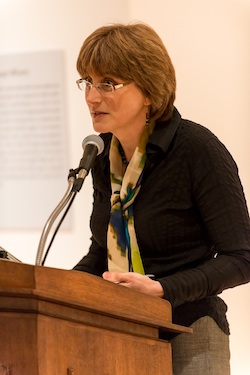Lily
After Calla Lily II by Ellsworth Kelly
I pause before the crayon contour of a lily
by a New York artist with an Irish name.
The line releases and I’m gone
for what he calls Calla is an Arum
or an Easter lily, and I’m torn:
remembrance, toiling, spinning
A terrible beauty is born
The altar lilies, surplice white,
at my son’s christening
in spring, in Shropshire;
the farflung family clustered round the font
a smell of must and stone
with Father Tom intoning
And down, and down, until
I reel you in, father.
Schooled, like MacNeice, to a foreign voice,
you come of Planter stock.
Your grandfather a seed merchant in Cork,
a Methodist, dour and tyrannical,
with a small estate and a big house
which he ruled with an iron thumb.
But you chose a life in England
and all of that’s long gone.
You swapped the iron thumb for a green one
and schooled me well on English plants.
For me this lily is named “Arum,” “Lords and Ladies,”
“Cuckoo-Pint,” “Jack-in-the-Pulpit,”
because that’s what you told me.
You’d kneel to point it out,
wild in the woodlands on our walks,
finger its single, waxen bract.
You said the plant was poisonous.
You knew everything, I thought,
a walking encyclopedia.
Why did you never then reveal this lily’s
Irish side as symbol of remembrance
marking the Easter Rising and its dead?
What did you think of all that, anyway?
Ulster in flames, armed squaddies, hunger strikes,
check points, surveillance, bombs, internment camps.
Trips to your parents’ house in Ire Land
in those days were often tense, explosive,
but the Troubles, never talked of.
How did you manage otherness?
What else have you not told?
I need to know: I too
have crossed the water, even further.
Too late to ask you now.
Your brain is self-destructing, faulty
connections firing off at random.
But you cling to Ireland through
long nights of grim delusion, like a drowning man
to spars of floating wreckage, reciting endlessly
your childhood address: Where do I live now?
Ferry House, Currabinny, Co. Cork.
A fine place, indeed…Cork Harbor,
sailing boats…now, what is my address? Oh yes…
There are two chaplains at the hospital
and both visit you. The Catholic comes first,
offering Mass: small, lithe, a smoker’s
deep-scored countenance, a quick, warm grin.
You light up when he enters, for his speech
is southern Irish. You mention Currabinny
and the man smiles back
and says some words in Gaelic.
A blank. You do not know
a word of Irish, not even hello.
A kinship, then, but also,
still, four centuries on, that tribal gulf:
the Gael from the Anglo-Irish.
You do not take communion
with him but from the other
chap, who’s Anglican,
tall, gauche, and plummy,
just like you.
So, each to each.
Aye, there’s the rub.
Tell me: how does the heart survive
its transplantation?
Does what is won
ever outweigh the cost?
He makes it seem so simple, Kelly.
One pure line, only one name.
How could he be so sure of how to draw this flower—
Calla, Easter, Arum? I’m still torn—
this funeral flower, whose pale calyx
holds so much: allegiance, country, clan, all hidden
in that creamy spathe with its big, rude spike
that’s clad in bright red berries in the woods
in autumn, when the flowering’s done.
—Catherine Jagoe
Notes for "Lily":
“A terrible beauty is born” is the refrain in William Yeats’ poem Easter, 1916.
Poet Louis MacNeice (1907–1963), an Irish Protestant, was sent to school in England at the age of ten and subsequently made his life there. The quotation comes from his poem Carrick Revisited and the full line reads “Schooled from the age of ten to a foreign voice.”
“Planters” is the name given to the British colonists who were brought in to settle land confiscated from the Irish “Gaels” by the English Crown in the sixteenth and seventeenth century.
The Easter Lily is a badge worn to commemorate Irish republican deaths during and after the Easter Rising of 1916 in Dublin. It is now inextricably linked to the IRA and the conflict between Roman Catholic republicans and Protestant unionists in Northern Ireland.
“each to each” is a phrase from T.S. Eliot’s The Love Song of J. Alfred Prufrock.
“Aye, there’s the rub” is a phrase spoken by Hamlet.


